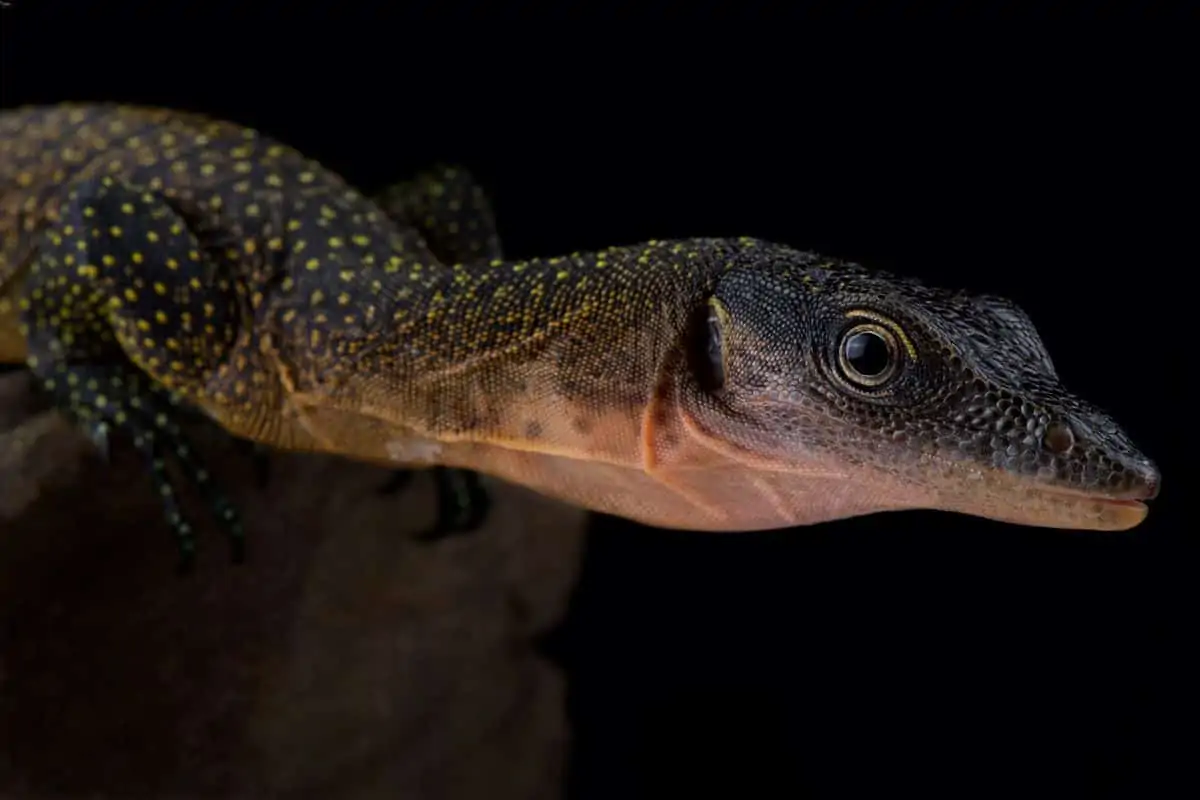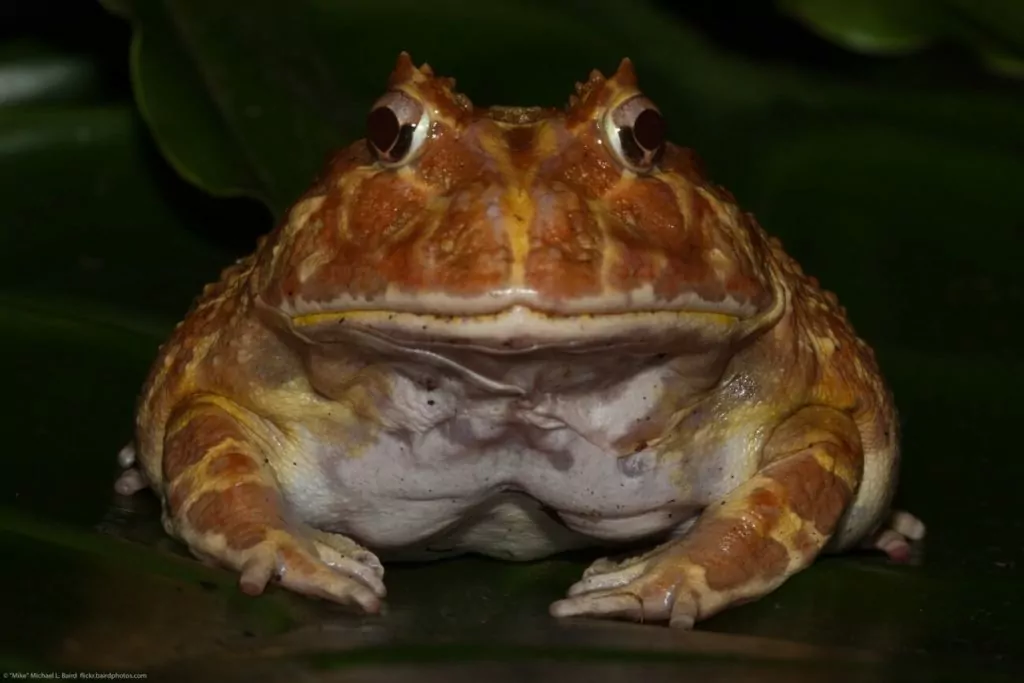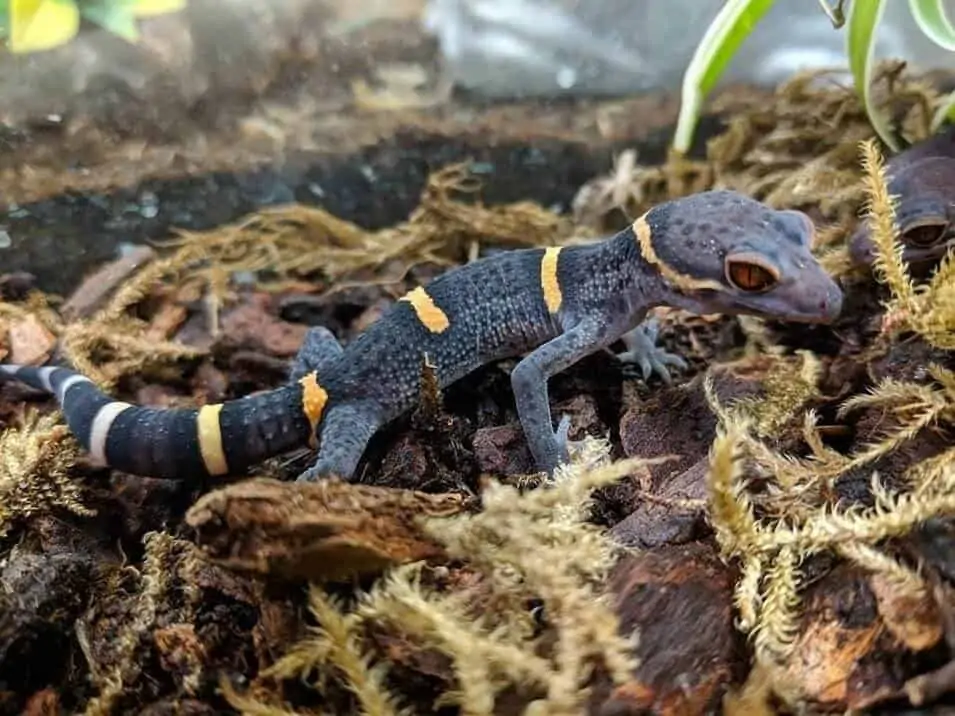Peach throat monitors are amazing reptiles that can make great pets in the hands of an experienced owner. They’re gorgeous and quite fun to observe!
But it’s important to have an accurate understanding of the amount of attention and care that these lizards need in order to thrive. This is not a pet that you can purchase without preparation and experience.
This guide will cover peach throat monitor care in its entirety to help you prepare for the task ahead. These reptiles can be incredibly rewarding to own as long as you’re ready to meet their requirements!
Table of Contents
Species Summary
The peach throat monitor (Varanus jobiensis) is sometimes also known as the Sepik monitor. In the wild, this monitor can be found in the rainforest areas of New Guinea and nearby islands like Yapen and Salawati.
Due to its large size and tricky care requirements, we feel that the peach throat monitor should only be considered as a pet lizard for intermediate to advanced reptile owners. While some less-experienced owners have gotten away with keeping these monitors, the success rate and quality of life of their pet is suboptimal (in our opinion).
If you fall into this category, and decide that you’re willing to put forth the necessary time to care for one of these gorgeous monitors, then you will be in for years of interest and enjoyment.
Appearance & Colors
As its name suggests, the peach throat monitor does indeed have a lovely peachy colored throat. This throat color can also be a kind of salmon or pinkish color. The skin of this monitor is often a brownish-olive that is patterned with bright yellow spots.
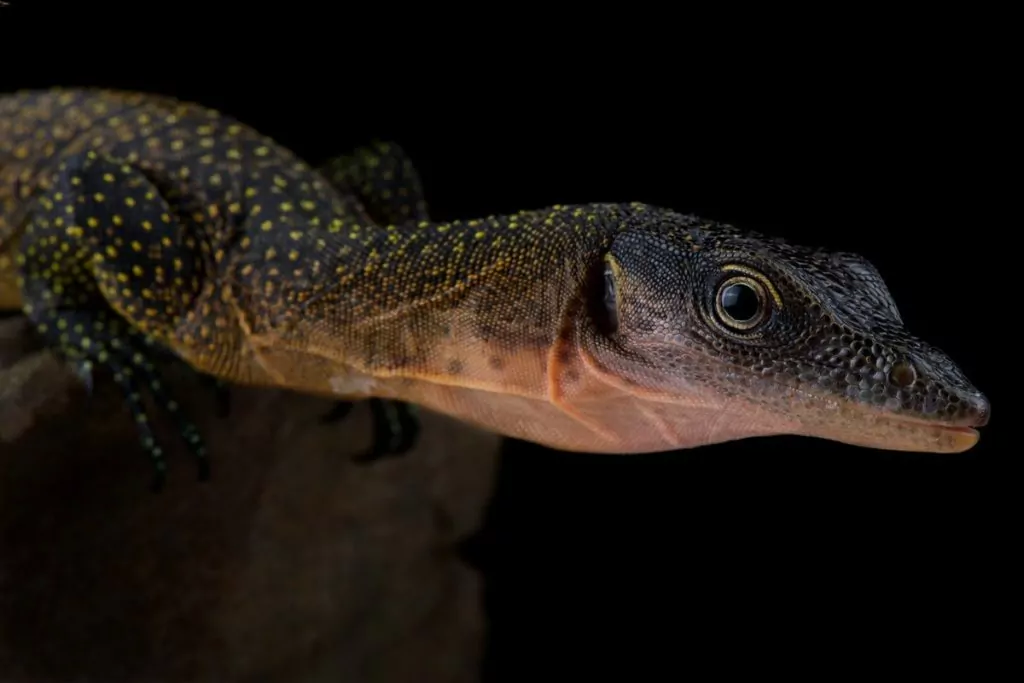
With a long neck, strong body, sharp claws and sharp teeth, the peach throat monitor displays typical monitor features. They also have a long tail that starts to get significantly thinner halfway down.
One of the features that many owners like about these intelligent reptiles is their wide and expressive eyes. They really look quite sweet!
Average Peach Throat Monitor Size
The average length of a peach throat monitor is around three to four feet in length when fully grown. These are not small lizards!
Because of this, they need a sizable enclosure in order to thrive. Make sure you’re prepared to do the necessary work to create a living environment that is large enough for them to be comfortable before you get one!
Expert Tip: Quality of care and genetics are the two main elements that impact the maximum size of these lizards in captivity. To give yourself the best chance of getting a peach throat monitor with good genetics, purchase them from a trustworthy and experienced seller.
Lifespan
The typical peach throat monitor lifespan is somewhere between 10 and 15 years in captivity. This is a very respectable life expectancy, and will give plenty of time to build a strong bond.
These reptiles need a nutritious diet and proper habitat setup in order to make this lifespan possible. If you do your job as an owner, you’ll probably have your monitor for quite a while.
Peach Throat Monitor Care
As previously mentioned, peach throat monitor care is best left to more experienced reptile owners. These monitors need a really big living space and pretty specific heat, light and humidity requirements.
Owners will also need to have a decent working knowledge of feeding and handling practices when dealing with this species. These monitors have sharp claws and a powerful tail!
Follow the recommendations below to ensure that your peach-throated monitor thrives.
Enclosure Size
Before you make the decision to care for a peach throat monitor, you really need to take the size of its enclosure into consideration. An adult monitor can be four feet long, and it’s going to need lots of space in which to climb, explore and hide!
Because the peach throat monitor needs so much living space, any enclosure you create should be no less than 10 by 6.5 by 6.5 feet.
Expert Tip: If you can create a larger area, then that is even better. This is a reptile that will appreciate the extra space.
Peach throat monitors are rough on their living space, so make sure to create one from sturdy, non-splintering materials.
Like many lizards, this monitor has the tendency to rub its nose on the sides of the enclosure. For this reason, it’s very important to create some kind of separation between the monitor and the screen around the enclosure. Snout rubbing against the screen can cause serious injuries.
Habitat Setup
In order to make your peach throat monitor as comfortable and happy as possible, you’ll want to create a living environment that promotes the physical and emotional well-being of your pet. Setting up a living space that is as close to “home” as possible should be your goal.
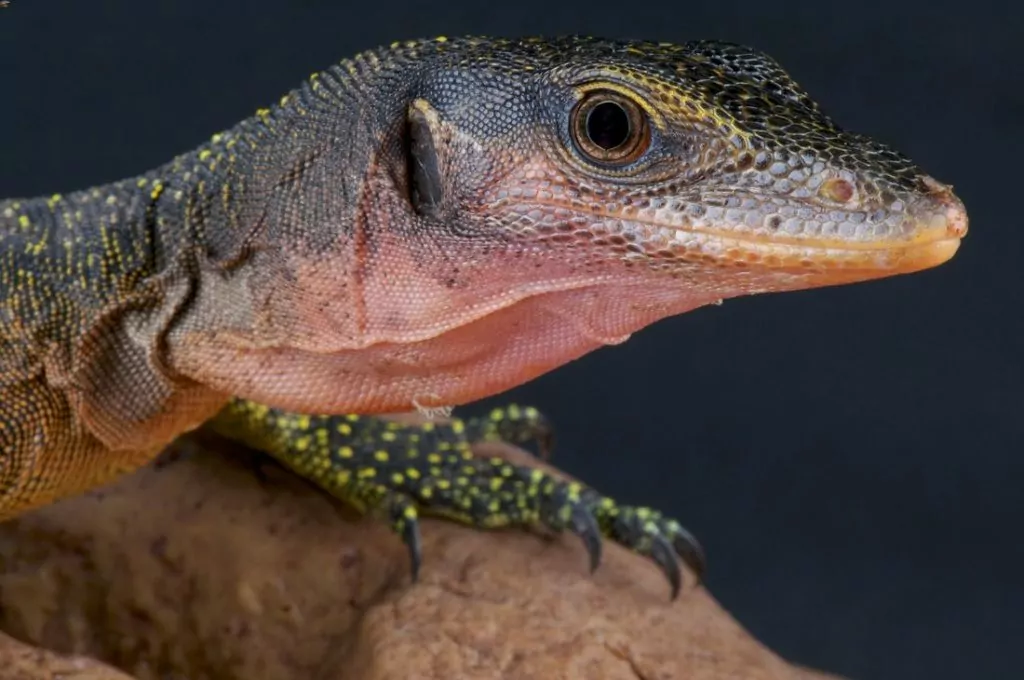
Having a substrate that can help retain moisture within the enclosure is important. You can use things like cypress mulch, coconut bark, or you can mix the bark with a little soil. Whichever substrate you choose, make sure to create about a five inch layer. These monitors really love to burrow.
Even though peach throat monitors are basically terrestrial, they still enjoy having things to climb on. Placing a nice, strong tree trunk in the enclosure will give your monitor a place to climb and bask.
Expert Tip: Adding artificial plants that have big leaves is another good idea. These plants can provide shade and places to hide.
Temperature & Lighting
When you’re setting up your monitor’s enclosure, you’ll need to plan for some kind of temperature gradient. A peach throat monitor, like any reptile, is not able to internally regulate its body temperature.
Setting up separate basking and cool-down areas will give your monitor the opportunity to raise or lower its temperature as needed.
The gradient that you will need to maintain is between 85 and 90 degrees Fahrenheit. Below are some ranges you’ll need to know:
- The warmer section (the basking area) should remain at 95 degrees Fahrenheit
- It’s fine if ambient temperatures in the rest of the enclosure drop to around 75 degrees Fahrenheit at night. A heat lamp, placed above the enclosure, should be enough to provide the required amount of heat.
As far as lighting goes, it’s recommended that you keep a 12 hours on, 12 hours off schedule.
Although it’s not necessary, it’s a good idea to provide your peach throat monitor with some type of supplemental UVB lighting. Because these lizards often receive the nutrients they need from their food, you’ll only need to keep the UVB light on for half an hour or so.
Humidity
Because the peach throat monitor comes from a tropical region, the humidity within its enclosure should remain at 70 to 90 percent at all times. Misting the enclosure and using a good substrate will help to maintain this high level of humidity.
Expert Tip: Make sure you get a well-made hygrometer to monitor the humidity in the enclosure. Cheap hygrometers are notorious for giving false or inaccurate readings, causing owners to make unnecessary changes that actually harm their pet!
Water
Even though peach throat monitors are not really known to be swimmers, they will still enjoy having a large water source where they can be completely immersed. This will also help maintain the high level of humidity that these reptiles need inside the enclosure.
It’s important to make sure that you choose a water container that is sturdy and that won’t tip over and make a mess inside the enclosure.
Also, monitors are notoriously messy, so be prepared to replace their water several times a day. The whole water container should be carefully cleaned once a week as well. This will help prevent harmful bacteria from growing inside the enclosure.
Food & Diet
Peach throat monitors are not overly picky when it comes to food. Your monitor will eat just about anything from mealworms and crickets to pre-killed rodents and even canned dog food.
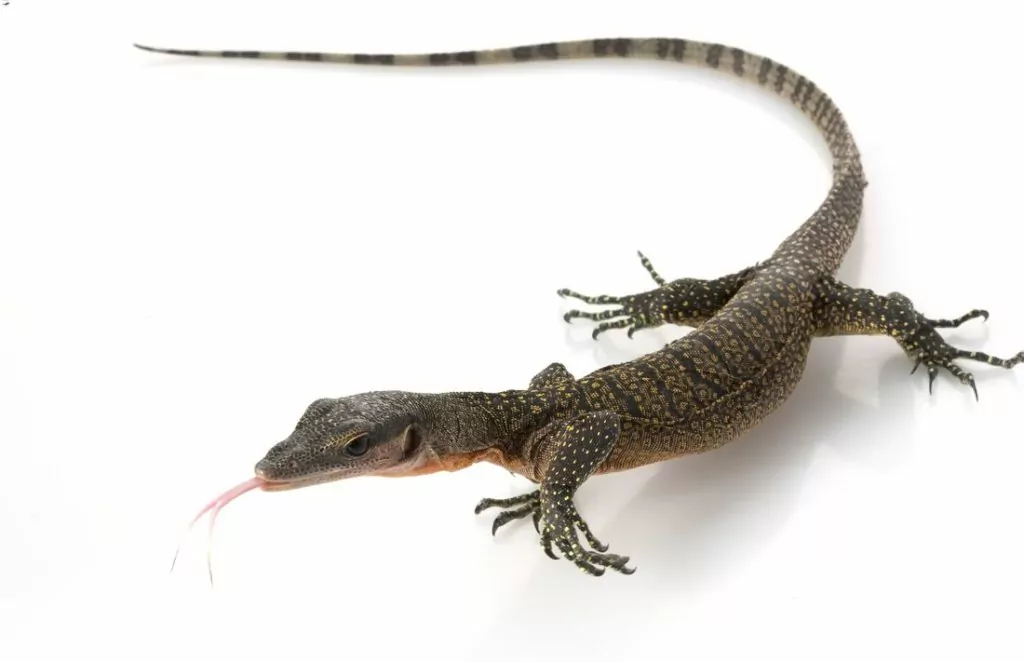
Very young monitors can be fed live food items like crickets, waxworms or mealworms. Juveniles and adults can have pre-killed rodents or fresh shrimp along with the already mentioned insects.
It’s a very good idea to gut load the insects before they are fed to your monitor. You can do this by giving the insects things such as leafy greens or fresh fruit. Also, we recommend dusting all prey with a calcium and vitamin supplement prior to feeding time.
Expert Tip: Some monitor owners will catch wild grasshoppers or crickets, but this is not really recommended. Wild-caught insects are often exposed to pesticides, and your monitor could become seriously or even fatally ill.
Potential Health Issues
Peach throat monitors have many of the same potential health issues that other types of monitor lizards have. These issues include respiratory infections, constipation, parasites, skin infections, injuries and calcium and vitamin deficiencies.
These issues can come up suddenly, so it’s always important to really observe your monitor and to check for signs that it may not be feeling well.
If you notice breathing issues, excess mucus, lethargy, lack of appetite or cuts and scrapes, you will need to take your peach throat monitor to the veterinarian for treatment. If it’s possible, use a veterinarian who has experience with exotic reptiles (it’s best to find one before you purchase your monitor).
Behavior & Temperament
Peach-throated monitors are not particularly aggressive by nature, and they would rather be left in peace. New monitors tend to be quite nervous and will often run around the enclosure in a frantic manner, but this behavior should calm down with patience and time.
Peach throat monitors have very sharp teeth and a powerful tail, and they will use it against you if they feel threatened. They are also known to defecate on a perceived threat, and that most likely means you.
Mostly, these monitors simply like to climb around their enclosure, burrow, explore or hide. They are actually quite a fun species to observe!
Handling Them
Peach throat monitors do not like to be handled, and they do best if they are left alone. True reptile enthusiasts will understand that seeing a monitor that’s happy and healthy is more important than trying to pick it up or over handle it.
Be mindful of their mood when cleaning the enclosure or adjusting/repairing their habitat. If your pet seems on edge, come back later when they’re a bit more relaxed.
Conclusion
We hope this care sheet about peach throat monitors has done an effective job of preparing you for how much work is required if you want to own these reptiles.
While it might seem a little intimidating at first, a lot of it comes down to putting in the necessary initial work. Planning out their enclosure and getting the necessary supplies is where you’ll spend most of your time.
Once you have everything set up, the rest is a lot easier. While it might not be easy one hundred percent of the time, the fulfillment of helping these lizards lead a happy and healthy life is definitely worth it.

